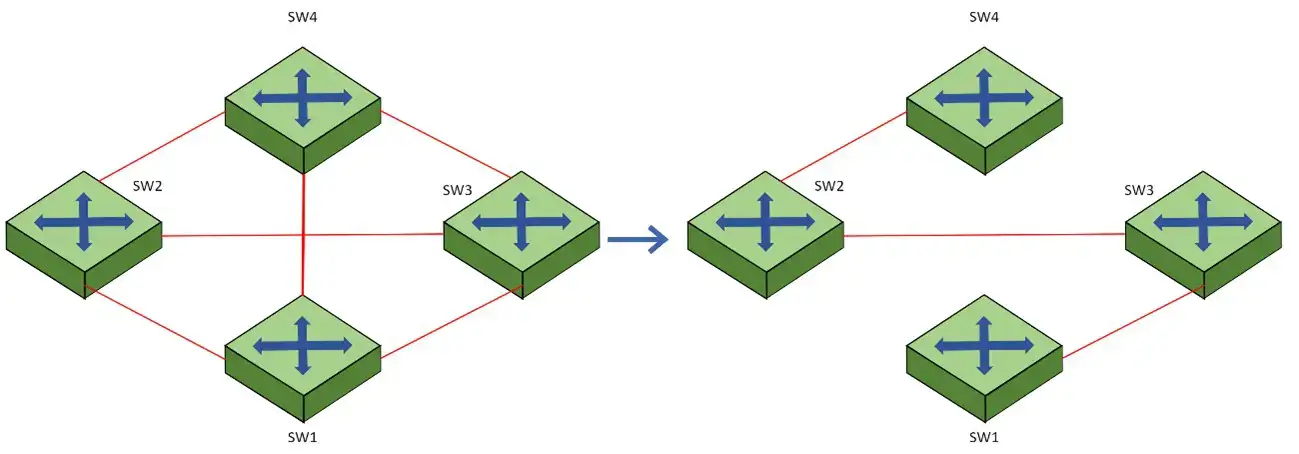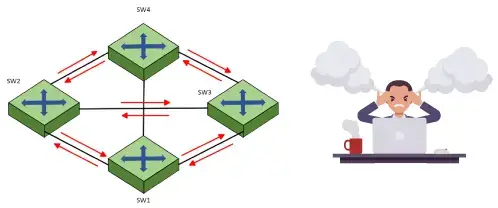 In the boundless realm of telecommunications, making sure networks run efficiently and undisturbed is crucial. Today, we are going to focus on the fascinating Spanning Tree algorithm (STP) and its relationship with switching. We will find out how this unsung hero keeps our networks free from loops and running smoothly.
In the boundless realm of telecommunications, making sure networks run efficiently and undisturbed is crucial. Today, we are going to focus on the fascinating Spanning Tree algorithm (STP) and its relationship with switching. We will find out how this unsung hero keeps our networks free from loops and running smoothly.
The evolution of the Spanning Tree Protocol
STP was developed by Radia Perlman in 1985, while she was working for Digital Equipment Corporation. At the time, Ethernet networks were growing quickly and faced a critical problem: network loops.
Imagine your network is a city full of interconnected streets. Without proper traffic control, you could end up in a never-ending bottleneck. Similarly, network loops were duplicating data packages and making them flow indefinitely, saturating the network and causing failures. Here is where STP steps in, acting as a traffic warden that prevents these loops from happening and keeps the network in check.
The core of the matter: What is the Spanning Tree algorithm and how does it work?
The Spanning Tree algorithm identifies the network’s topology and temporarily disables redundant links. Here we show you how:
1. Root Bridge selection: STP starts by selecting a “Root Bridge” for the network, based on the Bridge ID below (a combination of MAC address and priority). The Root Bridge acts like a reference point for network topology.
2. Shortest paths: Each switch calculates the shortest path to the Root Bridge based on its cost (i.e., the link’s speed). The port with the shortest path is called “Root Port”.
3. Designated Ports: For each network segment, a “Designated Port” is selected as the one that has the lowest cost path to the Root Bridge. This port forwards traffic to and from this segment.
4. Disabling of redundant ports: Any port that is not a Root Port or a Designated Port is blocked, thus preventing loops from forming.
This dynamic process ensures there is always a single active route between two points in the network, getting rid of dreaded loops.
Types of Spanning Tree Protocol
With time, several STP versions have been developed to improve efficiency and adapt to a network’s changing needs. The most important versions are described below:
1. STP (802.1D): It is the protocol’s original version and it is still widely used. However, it may be slow when it comes to converging (meaning it can react slowly to changes in the network’s topology).
2. RSTP (802.1w): The Rapid Spanning Tree Protocol is an improved STP version, designed to accelerate convergence times. RSTP can reconfigure the network in a matter of seconds instead of minutes, making it more suitable for dynamic environments.
3. MSTP (802.1s): The Multiple Spanning Tree Protocol allows the use of multiple STP instances in a single network, each one managing a different VLAN. This optimizes bandwidth utilization and improves efficiency in large and complex networks.
4. PVST+: The Per-VLAN Spanning Tree Plus is a proprietary version developed by a manufacturer that runs an STP instance per VLAN, giving more flexibility and control over the network’s topology.
5. RPVST+: The Rapid Per-VLAN Spanning Tree Plus combines the advantages offered by the RSTP and PVST+, providing quick convergence through each VLAN. This protocol is perfect for environments that require high availability and speed.
Common problems: Broadcast storms and their relationship with STP
An incorrect implementation or failure on the part of the Spanning Tree Protocol can cause significant network problems. One of the most serious ones is known as “broadcast storms”. But what exactly are these storms and how are they related to STP?
A broadcast storm happens when a network loop causes broadcast messages to multiply and flow incessantly, jamming the available bandwidth and hindering network performance. Broadcast messages are sent to all devices in the network and, in the presence of a loop, can replicate indefinitely.
Causes for STP-related broadcast storms
1. Incorrect STP configuration: If switches are not properly configured to run the STP, they can fail when blocking unnecessary ports and allow loops to happen.
2. STP convergence failures: In networks where STP does not converge quickly (i.e., when using the standard STP), changes in topology can cause temporary loops that become broadcast storms.
3. Incompatibility among STP versions: The coexistence of different STP versions in the same network can cause interoperability problems that may give rise to unexpected configurations and networks loops.
Broadcast storm prevention:
-RSTP or MSTP implementation: Using the most advanced STP versions, like RSTP or MSTP, with quicker convergence times makes it easier to adapt to changes in network topology.
-Correct port configuration: Making sure that all switch ports are properly configured to run STP and that redundant ports are correctly blocked is essential.
-Monitoring and maintenance: Continuously monitoring the network and adjusting configuration settings when needed is crucial for STP to work as expected.
Spanning Tree Protocol advantages: Keeping networks afloat
The Spanning Tree Protocol offers multiple advantages that are crucial for switching networks:
-Fewer network loops: The biggest advantage is the removal of network loops, avoiding congestion and network failures.
-High availability: STP allows backup routes to activate automatically when the main links fail, thus guaranteeing the network is always available.
-Scalability: By efficiently managing redundant links, STP allows networks to grow without sacrificing stability.
Findings related to the Spanning Tree Protocol
The Spanning Tree algorithm is a key element when designing and running robust and reliable switching networks. By preventing loops and efficiently managing data paths, STP ensures networks are scalable and remain operational (even in adverse circumstances).
At Teldat, we understand how important these technologies are and we work tirelessly to implement network solutions that incorporate STP and other advanced protocols. Our goal is to provide networks that are not only efficient, but also future-ready and resilient. Next time you connect to a network smoothly, think about the Spanning Tree Protocol and on how it manages to keep everything running like clockwork.




























